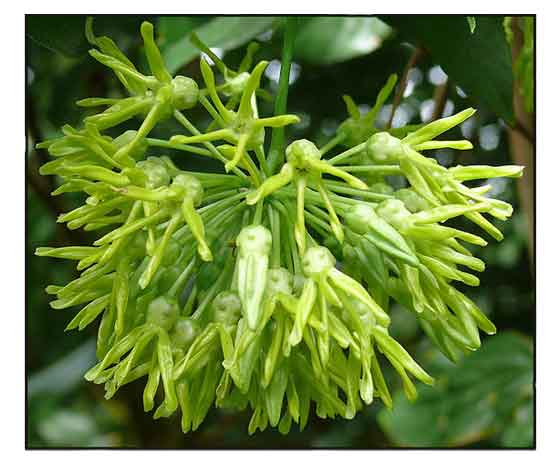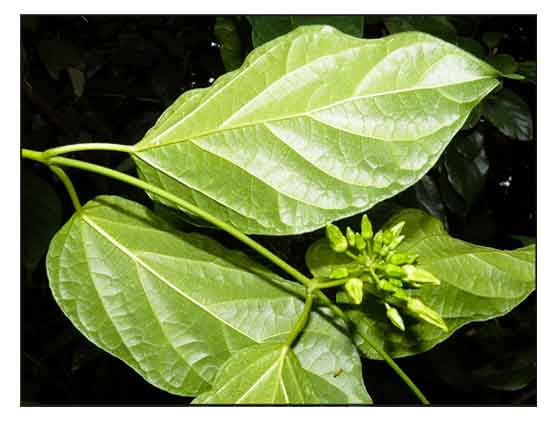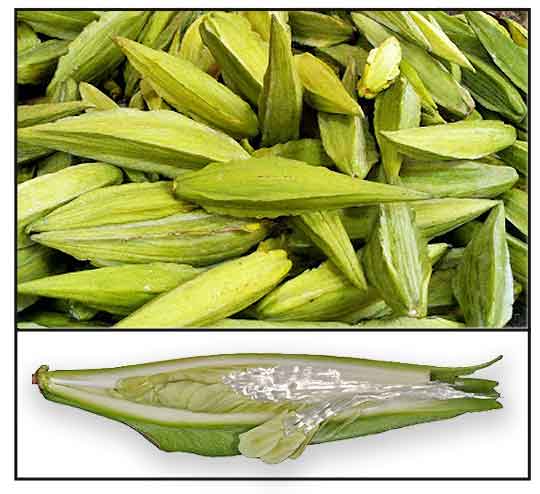 General info General info
- Telosma is a genus of plants in the family Apocynaceae, first described in 1905.
- Telosma procumbens is a species of flowering plant native to the Philippines and parts of southeastern China and Vietnam.
- Kapas-kapas means "resembling cotton".
- Etymology: The genus name Telosma derives from Greek words telos, meaning "end" or "finishing" and skhoma, meaning "form", referring to the characteristic shape or form at the end of the growth. Species epithet derives from Latin procumbens, meaning "lying down" or "prostrate", referring to the plants habit of sprawling or lying flat in the ground.
Botany
• Latok is a woody vine with slender, smooth or slightly hairy branchlets. Leaves are thin, ovate to oblong-ovate, 8 to 13 centimeters long, 3 to 8 centimeters wide, pointed at the tip and slightly heart-shaped at the base. Cymes are axillary and umbelliform. Flowers are numerous, greenish-yellow, odorless, about 1.5 centimeters long, and hairy at the throat. Fruit is lanceolate, about 15 centimeters long. Seeds are flattened and crowned with silky hairs.
 • Stems to 4 m, glabrous, young branchlets puberulent. Petiole 1.5-3.5 cm; leaf blade ovate, oblong or oblong-elliptic, 6-13 × 3-8 cm, membranous, glabrous to puberulent along veins, base broadly cuneate to subcordate, apex acute to acuminate; lateral veins ca. 6 pairs. Cymes extra-axillary, umbel-like, many flowered; peduncle 1-3 cm. Pedicel 1-1.5 cm. Sepals oblong-elliptic or ovate, ca. 3.5 × 2 mm, puberulent. Corolla greenish or greenish yellow, odorless, ca. 1.5 cm; tube up to as long as lobes, throat villous, interior with 5 narrow lines of hairs; lobes oblong, ca. 8 × 2.5 mm, rounded or subtruncate at apex, glabrous outside, puberulent inside, ciliate. Corona lobes acuminate, as high as or higher than anther appendages, abaxially convex. Pollinia oblong, erect. Stigma head short conical. Follicles lanceolate, ca. 10 × 2 cm. (Flora of China) • Stems to 4 m, glabrous, young branchlets puberulent. Petiole 1.5-3.5 cm; leaf blade ovate, oblong or oblong-elliptic, 6-13 × 3-8 cm, membranous, glabrous to puberulent along veins, base broadly cuneate to subcordate, apex acute to acuminate; lateral veins ca. 6 pairs. Cymes extra-axillary, umbel-like, many flowered; peduncle 1-3 cm. Pedicel 1-1.5 cm. Sepals oblong-elliptic or ovate, ca. 3.5 × 2 mm, puberulent. Corolla greenish or greenish yellow, odorless, ca. 1.5 cm; tube up to as long as lobes, throat villous, interior with 5 narrow lines of hairs; lobes oblong, ca. 8 × 2.5 mm, rounded or subtruncate at apex, glabrous outside, puberulent inside, ciliate. Corona lobes acuminate, as high as or higher than anther appendages, abaxially convex. Pollinia oblong, erect. Stigma head short conical. Follicles lanceolate, ca. 10 × 2 cm. (Flora of China)
Distribution
- Native to the Philippines.
- In thickets and secondary forests at low altitudes in Ilocos Norte to Sorsogon Provinces in Luzon; and in Mindoro, Cuyo, Biliran, Leyte, Negros, Mindanao and Basilan.
- Also native to China South-Central, China Southeast, Hainan, Vietnam. (4)
Constituents
- Phytochemical studies have yielded phenol, flavonoid, coumarin, tannin, terpenoid, steroids, and cardiac glycoside. (5)
-
Study yielded an intensely sweet polyoxypregnance glycoside, telosmoside A, together with 17 other new glycosides. (See study below) (1)
Properties
- Reports of fresh leaves and stems being poisonous to pigs.
-
Considered anti-tussive, expectorant, hypoglycemic.
- Studies have suggested antioxidant, hypoglycemic, radical scavenging, sweetening, antimicrobial properties.
Parts used
Leaves, flowers.
 Uses Uses
Edibility
- Flowers and immature fruit rinds are eaten cooked.
-
Pericarp is cooked and eaten as vegetable, with the consistency and taste of string beans.
- In Albay, fresh leaves and stems have been reported to be poisonous to pigs.
- In Ilocos Norte, immature fruit (padpadol) used for making dinengdeng.
- Clustered inflorescence eaten as vegetable, sautéed and eaten with rice.
- Young fruits are grilled and paired with bagoong
- In everyday vegetable in Thailand, steamed or boiled and served with spicy Nam Pric, friend with eggs as omelet, sautéed with meat or added to hot and sour soup. (2)
Folkloric
- Decoction or infusion of leaves used for cleansing wounds, scabies and ulcers.
- Leaves, as cataplasm, applied to the forehead for headaches.
- In Vietnamese folk medicine, whole plant is used as a substitute for licorice, due to its sweet taste. Also used as expectorant and antitussive. (1)
Studies
• Telosmoside A15 / Pregnane Glycosides / Intensely Sweet: An intensely sweet polyoxypregnane glycoside, telosmoside A15, was isolated from Asian Telosma procumbens. The sweetness has an intensity 1000 times greater than that of sucrose. The plant also yielded 17 other new glycosides, telosmosides A1-A14, and A16-A18. Some of these glycosides are sweet, while others are tasteless and bitter. (1)
• Anti-Diabetic / Leaves: Study evaluated an ethanolic leaf extract of Telosma procumbens for hypoglycemic activity in alloxan-induced diabetic mice. Results showed a dose-dependent blood glucose reducing effect. Data suggests the presence of molecules with insulin-like bioctivity. The proposed mechanism is increase in insulin sensitivity due to saponins. (3) Study evaluated the hypoglycemic activity of ethanolic leaf extract in both normoglyycemic and alloxan-induced diabetic mice. Results showed dose-dependent blood glucose lowering effect. In diabetic mice, high dose of 100mg/kbw produced maximum decrease in glycemia (59%( 1 hour after treatment, comparable to the effect of insulin (65%). (8)
• Antimicrobial / Leaves and Flowers: Study evaluated the antimicrobial property of Telosma procumbens leaf and flower extracts against Staphylococcus aureus and Escherichia coli. Results showed antibacterial activity against S. aureus and E. coli with zones of inhibition of 20.67 and 23.67 mm for leaf extracts, respectively, and 16.67 mm and 20.67 mm for flower extracts, respectively. (5)
• Antioxidant / Radical Scavenging Activity: Study evaluated crude extracts of five common indigenous vegetables for radical scavenging activity i.e., Telosma procumbens, B. luzonica, Schismatoglottis sp., M. cochinchinensis, and M. verticillata. All five vegetables exhibited antioxidant activity. T. procumbens showed 50.10 ± 0.09 % radical scavenging activity. (6)
Availability
Wild-crafted.
|

![]()





 Uses
Uses